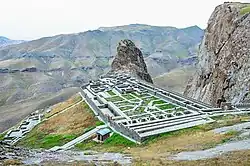Alinja Tower
The Alinja Tower,[1] also known as Alinjagala[2] or Alinja-gala[3][4][5] (Azerbaijani: Əlincə qalası)—earlier, up to the 14th century, known as the Armenian fortress Yernjak[6][7] (Armenian: Երնջակ[8])—is a tower is located to the west of Khanega village, not far from Julfa city in Azerbaijan, on the right coast of the Alinja River (Alinjachay), higher of the Armenian monastery St.Karapet,[9] on the top of Alinja Mountain.[10] The tower was one of the strongest defensive buildings of its time.[3]
| Alinja Tower | |
|---|---|
Azerbaijani: Əlincə qalası | |
 | |
| Former names | Alenjik or Alinje |
| General information | |
| Location | To the west of Khanega village, not far from Julfa city, Azerbaijan |
History
The first mentions are in sources from the 1st century. The tower was founded and belonged to the Armenian lords of Syunik.[6] It was one of the important fortress in Armenia.[11] By the 10th century the tower was in the hands of the Bagratuni dynasty. In 914 Yusuf ibn Abi'l-Saj occupied Dvin and took captivity King of Armenia Smbat I. After that, Yusuf wanted to occupy the Armenian citadel, which resisted the Arabian army too long. He killed Smbat I in front of Yernjak with the purpose to force handing the fortress.[12][13] Yernjak was captured to Arab emir of Goghtn a short time later. In the 13th century the fortress pass into the hands of the Armenian Orbelean family, who were lords of this part of Syunik.[6] Perhaps the tower was their residence.[14] In the 14th century, the tower already belonged to the Turkic dynasty of Ildegizids. Since then, Yernjak became called Alinja.[6]
The main treasury of Iraq Seljuks was kept in the tower of the Ildegizids.[4]
Defenders of the tower made strong resistance to occupants during the epoch of Timur’s invasion to this region. During 14 years, beleaguered soldiers defended the tower from Timur’s army and his son Miran Shah with the help of Georgians.
Construction
There are many hydrotechnical, defensive, residential and palatial buildings in the tower, which were on the top of the mountain and in its slopes. Strong rows of stone walls led from the outskirts of the mountain to the top in a few lines. Cistern-pools once keeping rain and melt water remained in the shadow. The main treasury of Azerbaijani Atabeys was kept in Alinjagala tower.
References
- Нахичеванская Республика. Словарь современных географических названий. Екатеринбург: У-Фактория. 2006.
- Под ред. Б. Н. Пономарева (1966). История СССР с древнейших времен до наших дней. Академия наук СССР: Наука. p. 518.
- Л. С. Бретаницкий (1966). Зодчество Азербайджана XII-XV вв. и его место в архитектуре Переднего Востока. Наука. p. 556.
- Российское палестинское общество. (1970). Палестинский сборник, Выпуск 21. Ближний Восток и Иран. Ленинград: Наука. p. 193.
- Нахичеванская Автономная Советская Социалистическая Республика (1967). Г. А. Мадатов. Советская историческая энциклопедия, Москва: Советская энциклопедия.
- «Крепость Ернджак (Алинджа-кала)» /Бюллетень Кавказского историко-археологицкского института в Тифлисе, Выпуски 1-8 / p.16 – Изд-во Академия наук СССР, 1928
- Иван Шопен (1852). Исторический памятник состояния Армянской-области в эпоху ея присоединения к Российской-Империи. Имп. Академии наук. p. 324.
Ханъ-ага. Выше селенія этого имени возвышается неприступная гора на вершинѣ котороіі находится извѣстная крѣпость Ернджакъ, нынѣ Алинджа
- Словарь топонимов Армении: Том 2. Pages 246-247.
- Обозрение российских владений за Кавказом, в статистическом, этногафическом, топографическом и финансовом отношениях / Directmedia, 2013 ISBN 5446026128, 9785446026128 - p.336
- Карта J-38-32. Издание 1975 г.
- Robert H. Hewsen. Armenia: A Historical Atlas. — University of Chicago Press, 2001. — 341 p. — ISBN 0226332284, ISBN 9780226332284. P. 121.
- Lynn Jones Archived 2015-01-04 at the Wayback Machine. Between Islam and Byzantium: Aght’amar and the Visual Construction of Medieval Armenian Rulership. Ashgate Publishing, Ltd., 2007, P. 66 «In 913 Yusuf again stormed Duin; this time he took Smbat prisoner. Smbat remained at Duin until 914, when Yusuf, unable to take the Bagratuni fortress of Emjak»
- Щеблыкин И. П. Памятники азербайджанского зодчества эпохи Низами (материалы) / Под ред. И. Джафарзаде. — Б.: Издательство АзФАН, 1943.
- Steven Runciman (1988). The Emperor Romanus Lecapenus and his reign: a study of tenth-century Byzantium. Cambridge University Press. pp. 160–161.:
The third great family of Armenia was the Orbelians of Siounia. Siounia was the large canton to the east of the country, which stretched from Lake Sevan to the southernmost bend of the Araxes. Siounia was subdivided among various members of the princely house, and possessions seem to have changed hands among them fairly frequently. There were main branches of the family; of the elder the head at the time of Sembat’s martyrdom was the Grand Ischkan Sembat whose possessions lay on the west of Siounia, including Vaiotzor and Sisagan (which he apparently acquired from his cousins of the younger branch) and extending down to Nakhidchevan. He had married an Ardzrouni princess, Sophie, Gagic’s sister, and was one of the most prominent figures in Armenia. His brother Sahac owned the districts of Siounia on the east, with his capital probably at Erendchac; a third brother Papgen, the villain of the family, owned a town or two on the east and was jealous of his richer brothers; a fourth, Vasac, had already been killed in the interminable civil wars. The possessions of the younger branch clustered round Lake Sevan.